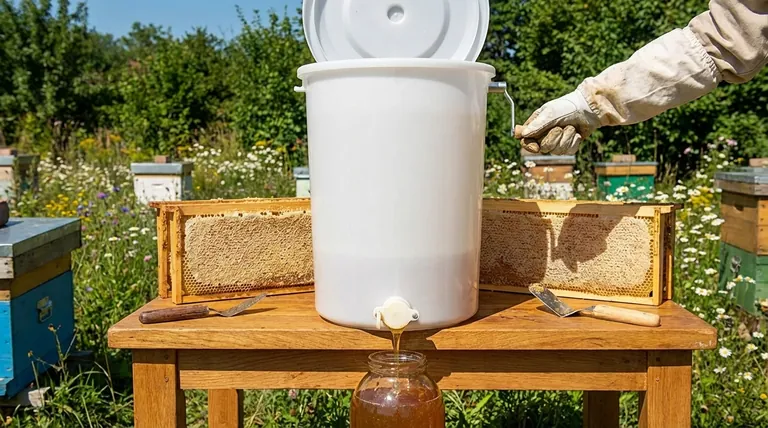For the beekeeper who values precision and independence, a manual honey extractor offers distinct advantages over its electric counterpart. The primary benefits are superior control over extraction speed, complete freedom from a power source, and a significantly lower initial cost. This makes it an accessible and practical tool, especially for hobbyists and those with remote apiaries.
Choosing a honey extractor is about aligning your equipment with your scale, budget, and beekeeping philosophy. A manual extractor excels by offering unparalleled control and affordability, making it the ideal tool for the hands-on hobbyist or beginner.

The Core Advantages of Manual Extraction
A manual extractor operates on a simple principle: a hand crank rotates a drum, using centrifugal force to pull honey from the frames. The benefits of this simple design are significant.
Absolute Control Over Speed
With a manual crank, you are in direct control of the rotational speed. You can start very slowly to extract honey from delicate, newly drawn comb without causing a "blowout" or destroying the wax structure.
This fine-tuned control is difficult to replicate with many entry-level electric models, which often have limited speed settings.
Financial Accessibility
Manual extractors are considerably more affordable than electric models. This lower cost of entry makes them an excellent choice for beginner beekeepers or those managing a small number of hives who cannot yet justify a larger investment.
Unplugged Independence
Because they require no electricity, manual extractors can be used anywhere. This is a critical advantage for beekeepers with hives in remote fields, backyards without convenient outlets, or off-grid locations.
This portability removes a major logistical barrier, allowing you to extract honey right at the apiary if you choose.
A Hands-On Approach
Many beekeepers prefer the tactile, physical involvement of a manual extractor. The process fosters a deeper connection to the harvest and is often described as more rewarding. The operation is straightforward, requiring little technical skill beyond the physical effort to turn the crank.
Understanding the Trade-offs: Manual vs. Electric
The decision to use a manual extractor involves clear trade-offs, primarily centered around effort and scale.
The Cost of Control: Physical Effort
The most obvious trade-off is labor. A manual extractor requires your physical energy to spin the frames. While manageable for a few hives, this can become exhausting and time-consuming with a larger honey harvest.
Electric models eliminate this effort, making the process much faster and less physically demanding, which is a key consideration for anyone with physical limitations.
The Efficiency Ceiling
Manual extractors are inherently less efficient for large-scale operations. An electric extractor can spin frames at a consistent, high speed, processing a larger volume of honey in a fraction of the time.
If you plan to expand your apiary beyond a hobbyist level, you will likely outgrow the capacity of a manual extractor quickly.
Key Design Considerations
When choosing a manual extractor, you will encounter a few design variations.
Crank Position: Models feature either a top-crank or side-crank design, which is largely a matter of ergonomic preference.
Material: Extractors are typically made of either food-grade plastic or stainless steel. Plastic is lighter and cheaper, while stainless steel is more durable, longer-lasting, and generally considered easier to clean.
Making the Right Choice for Your Apiary
Select your equipment based on your specific goals and context.
- If your primary focus is starting on a budget: A manual extractor is the most cost-effective entry point into honey processing.
- If your primary focus is preserving delicate comb: The fine-tuned speed control of a manual extractor is superior for protecting new or fragile wax.
- If your primary focus is harvesting in a remote location: A manual extractor's independence from electricity makes it the most practical choice.
- If your primary focus is future growth and efficiency: An electric extractor is a better long-term investment for handling larger volumes with less physical effort.
Ultimately, the best extractor is the one that seamlessly integrates with your personal beekeeping goals and workflow.
Summary Table:
| Advantage | Key Benefit | Ideal For |
|---|---|---|
| Speed Control | Prevents comb blowout; gentle on new wax | Delicate comb preservation |
| Cost-Effectiveness | Lower initial investment | Budget-conscious beekeepers |
| Portability & Independence | No electricity required | Remote apiaries & off-grid use |
| Hands-On Process | Tactile, rewarding experience | Hobbyists valuing connection to harvest |
Ready to find the perfect manual extractor for your apiary?
At HONESTBEE, we supply durable, high-quality beekeeping equipment to commercial apiaries and distributors. Whether you're a hobbyist starting out or a distributor stocking up, our wholesale-focused operations ensure you get the reliable tools you need for a successful harvest.
Contact our team today to discuss your needs and get a quote on our range of manual honey extractors and other essential beekeeping supplies.
Visual Guide

Related Products
- Plastic Hand Crank 2 Frame Honey Extractor Low Price
- 6 Frame Manual Stainless Steel Honey Extractor Beekeeping Equipment
- HONESTBEE 3-Frame Manual Acrylic Honey Extractor
- 2 Frame Stainless Steel Manual Honey Spinner Extractor for Beekeeping
- Easy Use Manual Stainless Steel Honey Press for Honey Comb
People Also Ask
- Can manual honey extractors effectively remove honey from cells? A Guide for Small-Scale Beekeepers
- How do you extract honey by hand? A Guide to Crush & Strain vs. Manual Extractor
- What are the general precautions to take when extracting honey? Ensure a Safe, Efficient Harvest
- Why are manual extractors popular among beginner beekeepers? A Guide to Starting Simple & Saving Money
- What makes polyurethane foam environmentally friendly? The Surprising Benefits of a Durable, Inert Material



















